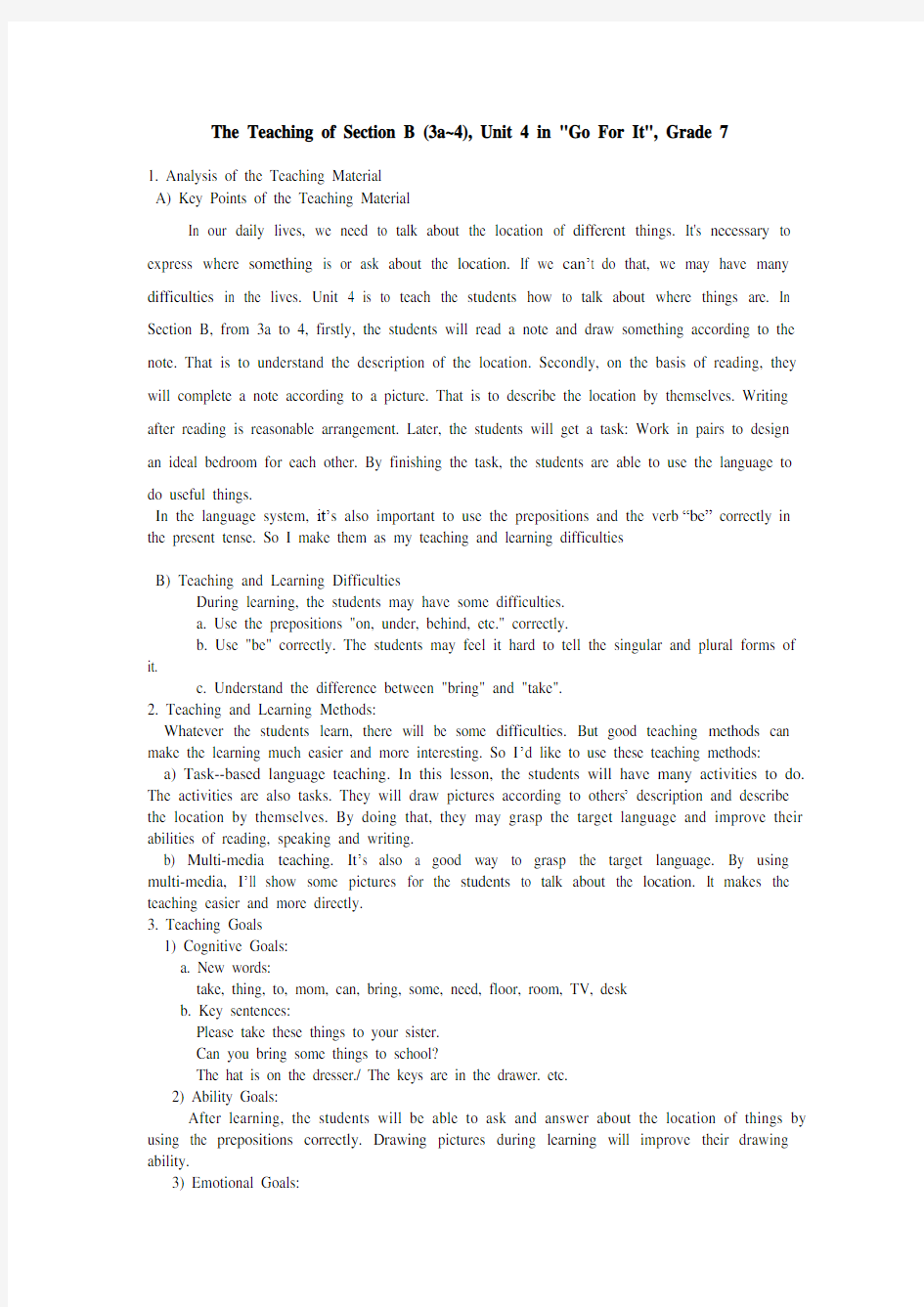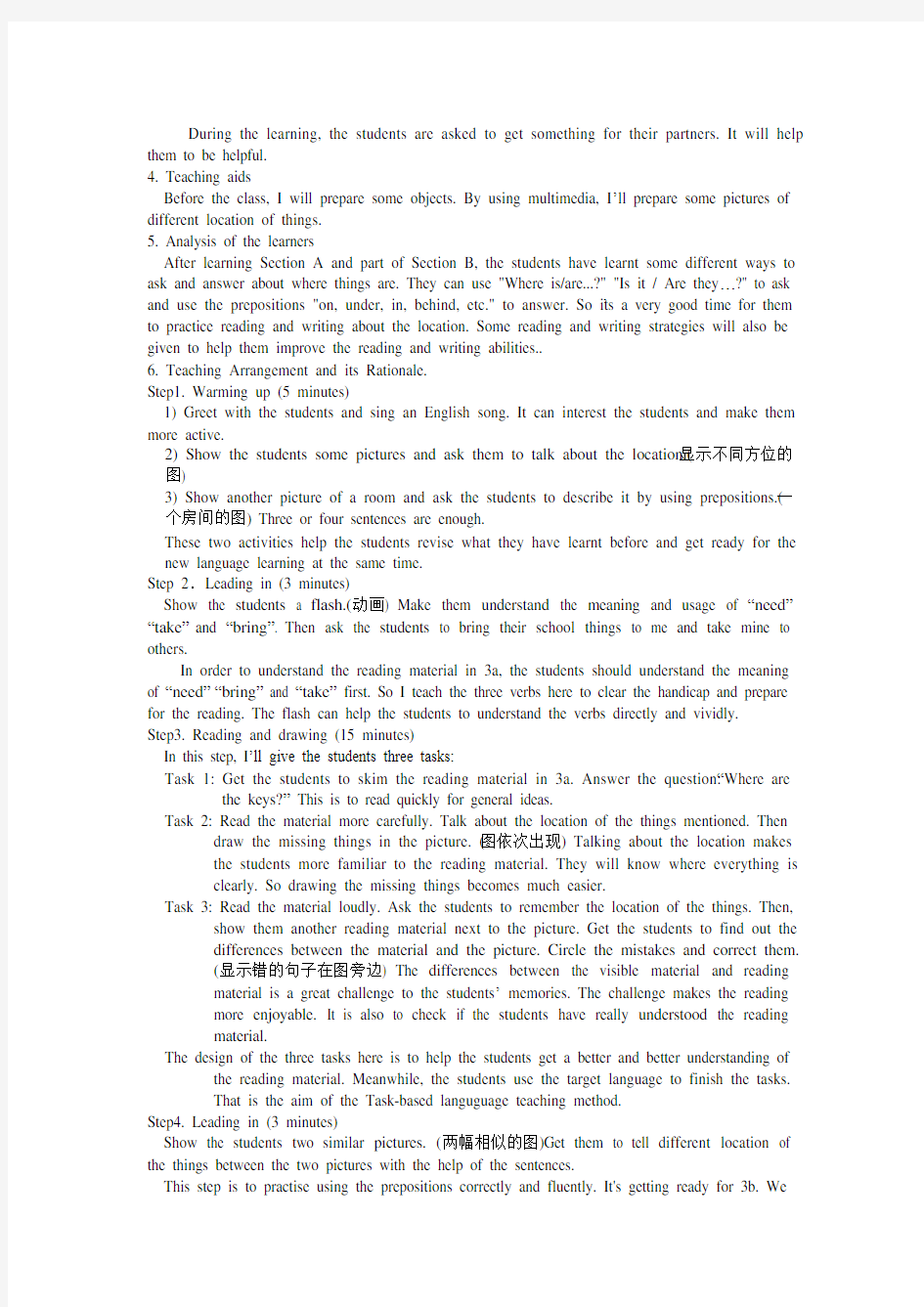宜昌说课稿UNIT4,GRADE7


The Teaching of Section B (3a~4), Unit 4 in "Go For It", Grade 7
1. Analysis of the Teaching Material
A) Key Points of the Teaching Material
In our daily lives, we need to talk about the location of different things. It's necessary to express where something is or ask about the location. If we can’t do that, we may have many difficulties in the lives. Unit 4 is to teach the students how to talk about where things are. In Section B, from 3a to 4, firstly, the students will read a note and draw something according to the note. That is to understand the description of the location. Secondly, on the basis of reading, they will complete a note according to a picture. That is to describe the location by themselves. Writing after reading is reasonable arrangement. Later, the students will get a task: Work in pairs to design an ideal bedroom for each other. By finishing the task, the students are able to use the language to do useful things.
In the language system, it’s also important to use the prepositions and the verb “be” correctly in the present tense. So I make them as my teaching and learning difficulties
B) Teaching and Learning Difficulties
During learning, the students may have some difficulties.
a. Use the prepositions "on, under, behind, etc." correctly.
b. Use "be" correctly. The students may feel it hard to tell the singular and plural forms of it.
c. Understand the difference between "bring" and "take".
2. Teaching and Learning Methods:
Whatever the students learn, there will be some difficulties. But good teaching methods can make the learning much easier and more interesting. So I’d like to use these teaching methods: a) Task--based language teaching. In this lesson, the students will have many activities to do. The activities are also tasks. They will draw pictures according to others’ description and describe the location by themselves. By doing that, they may grasp the target language and improve their abilities of reading, speaking and writing.
b) Multi-media teaching. It’s also a good way to grasp the target language. By using multi-media, I’ll show some pictures for the students to talk about the location. It makes the teaching easier and more directly.
3. Teaching Goals
1) Cognitive Goals:
a. New words:
take, thing, to, mom, can, bring, some, need, floor, room, TV, desk
b. Key sentences:
Please take these things to your sister.
Can you bring some things to school?
The hat is on the dresser./ The keys are in the drawer. etc.
2) Ability Goals:
After learning, the students will be able to ask and answer about the location of things by using the prepositions correctly. Drawing pictures during learning will improve their drawing ability.
3) Emotional Goals:
During the learning, the students are asked to get something for their partners. It will help them to be helpful.
4. Teaching aids
Before the class, I will prepare some objects. By using multimedia, I’ll prepare some pictures of different location of things.
5. Analysis of the learners
After learning Section A and part of Section B, the students have learnt some different ways to ask and answer about where things are. They can use "Where is/are...?" "Is it / Are they…?" to ask and use the prepositions "on, under, in, behind, etc." to answer. So it’s a very good time for them to practice reading and writing about the location. Some reading and writing strategies will also be given to help them improve the reading and writing abilities..
6. Teaching Arrangement and its Rationale.
Step1. Warming up (5 minutes)
1) Greet with the students and sing an English song. It can interest the students and make them more active.
2) Show the students some pictures and ask them to talk about the location.(显示不同方位的
图)
3) Show another picture of a room and ask the students to describe it by using prepositions.(一
个房间的图) Three or four sentences are enough.
These two activities help the students revise what they have learnt before and get ready for the new language learning at the same time.
Step 2.Leading in (3 minutes)
Show the students a flash.(动画) Make them understand the meaning and usage of “need”“take”and “bring”. Then ask the students to bring their school things to me and take mine to others.
In order to understand the reading material in 3a, the students should understand the meaning of “need”“bring” and “take” first. So I teach the three verbs here to clear the handicap and prepare for the reading. The flash can help the students to understand the verbs directly and vividly.
Step3. Reading and drawing (15 minutes)
In this step, I’ll give the students three tasks:
Task 1: Get the students to skim the reading material in 3a. Answer the question: “Where are the keys?” This is to read quickly for general ideas.
Task 2: Read the material more carefully. Talk about the location of the things mentioned. Then draw the missing things in the picture. (图依次出现) Talking about the location makes
the students more familiar to the reading material. They will know where everything is
clearly. So drawing the missing things becomes much easier.
Task 3: Read the material loudly. Ask the students to remember the location of the things. Then, show them another reading material next to the picture. Get the students to find out the
differences between the material and the picture. Circle the mistakes and correct them.
(显示错的句子在图旁边) The differences between the visible material and reading
material is a great challenge to the students’ memories. The challenge makes the reading
more enjoyable. It is also to check if the students have really understood the reading
material.
The design of the three tasks here is to help the students get a better and better understanding of the reading material. Meanwhile, the students use the target language to finish the tasks.
That is the aim of the Task-based languguage teaching method.
Step4. Leading in (3 minutes)
Show the students two similar pictures. (两幅相似的图)Get them to tell different location of the things between the two pictures with the help of the sentences.
This step is to practise using the prepositions correctly and fluently. It's getting ready for 3b. We
do oral practice before writing, it will be easier for the students to finish the task in 3b.
Step5. Writing (4 minutes)
Ask the students to talk about the picture in 3b by asking “Where is/are…?” Then complete the note according to the picture. The students may write like this:(3A的图及便条).
Talking about the picture can improve the students’ ability of observation. Completing the note is the guided writing. 3a has made an example for it. Meanwhile, it gets ready for the free writing in 3c.
Step6.Pairwork (10 minutes)
In this step, I’ll give the students the fourth task to do:
Task 4: Help me design the bedroom! Ask each student to design a bedroom for his/her partner. Write down the instructions of the design. They may write like this: “Put the bed near the window. Put…on/in/under…” After writing, the pairs will change their ideas. Ask some students to give a report of the design and choose the best one.
In this step, I give the students this task to do instead of writing a note in 3c. Because 3c is the free writing. The aim of it is to practice writing about the location of things. Since the students sit next to each other, why do they need to write a note? So I create this task.. It’s more believable and the teaching aim can also be achieved.
Step7. Homework
Get each student to draw a picture of his bedroom and get ready to describe it in the next lesson. Blackboard Design:
take...to... Please take these things to your sister.
bring...to... Can you bring some things to school?
The book is on the floor.
My TV is on the desk.
It is simple but clear. I have designed all the key points on the blackboard.
Assessment:
1.After teaching, I’ll see if the students can use prepositions to describe the location of things
correctly, including speaking, reading and writing.
2.Get each student to assess his performance in this lesson, including his drawing, speaking,
writing and so on.
It’s necessary to assess after class. By doing this, the students will make sure what they have learnt in this lesson. It will make them feel successful and be more interested in learning English.
